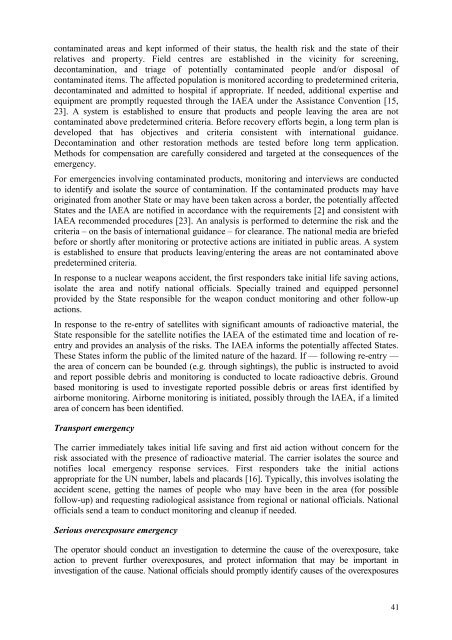epr-method (2003) - IAEA Publications - International Atomic Energy ...
epr-method (2003) - IAEA Publications - International Atomic Energy ...
epr-method (2003) - IAEA Publications - International Atomic Energy ...
Create successful ePaper yourself
Turn your PDF publications into a flip-book with our unique Google optimized e-Paper software.
contaminated areas and kept informed of their status, the health risk and the state of their<br />
relatives and property. Field centres are established in the vicinity for screening,<br />
decontamination, and triage of potentially contaminated people and/or disposal of<br />
contaminated items. The affected population is monitored according to predetermined criteria,<br />
decontaminated and admitted to hospital if appropriate. If needed, additional expertise and<br />
equipment are promptly requested through the <strong>IAEA</strong> under the Assistance Convention [15,<br />
23]. A system is established to ensure that products and people leaving the area are not<br />
contaminated above predetermined criteria. Before recovery efforts begin, a long term plan is<br />
developed that has objectives and criteria consistent with international guidance.<br />
Decontamination and other restoration <strong>method</strong>s are tested before long term application.<br />
Methods for compensation are carefully considered and targeted at the consequences of the<br />
emergency.<br />
For emergencies involving contaminated products, monitoring and interviews are conducted<br />
to identify and isolate the source of contamination. If the contaminated products may have<br />
originated from another State or may have been taken across a border, the potentially affected<br />
States and the <strong>IAEA</strong> are notified in accordance with the requirements [2] and consistent with<br />
<strong>IAEA</strong> recommended procedures [23]. An analysis is performed to determine the risk and the<br />
criteria – on the basis of international guidance – for clearance. The national media are briefed<br />
before or shortly after monitoring or protective actions are initiated in public areas. A system<br />
is established to ensure that products leaving/entering the areas are not contaminated above<br />
predetermined criteria.<br />
In response to a nuclear weapons accident, the first responders take initial life saving actions,<br />
isolate the area and notify national officials. Specially trained and equipped personnel<br />
provided by the State responsible for the weapon conduct monitoring and other follow-up<br />
actions.<br />
In response to the re-entry of satellites with significant amounts of radioactive material, the<br />
State responsible for the satellite notifies the <strong>IAEA</strong> of the estimated time and location of reentry<br />
and provides an analysis of the risks. The <strong>IAEA</strong> informs the potentially affected States.<br />
These States inform the public of the limited nature of the hazard. If — following re-entry —<br />
the area of concern can be bounded (e.g. through sightings), the public is instructed to avoid<br />
and report possible debris and monitoring is conducted to locate radioactive debris. Ground<br />
based monitoring is used to investigate reported possible debris or areas first identified by<br />
airborne monitoring. Airborne monitoring is initiated, possibly through the <strong>IAEA</strong>, if a limited<br />
area of concern has been identified.<br />
Transport emergency<br />
The carrier immediately takes initial life saving and first aid action without concern for the<br />
risk associated with the presence of radioactive material. The carrier isolates the source and<br />
notifies local emergency response services. First responders take the initial actions<br />
appropriate for the UN number, labels and placards [16]. Typically, this involves isolating the<br />
accident scene, getting the names of people who may have been in the area (for possible<br />
follow-up) and requesting radiological assistance from regional or national officials. National<br />
officials send a team to conduct monitoring and cleanup if needed.<br />
Serious overexposure emergency<br />
The operator should conduct an investigation to determine the cause of the overexposure, take<br />
action to prevent further overexposures, and protect information that may be important in<br />
investigation of the cause. National officials should promptly identify causes of the overexposures<br />
41

















